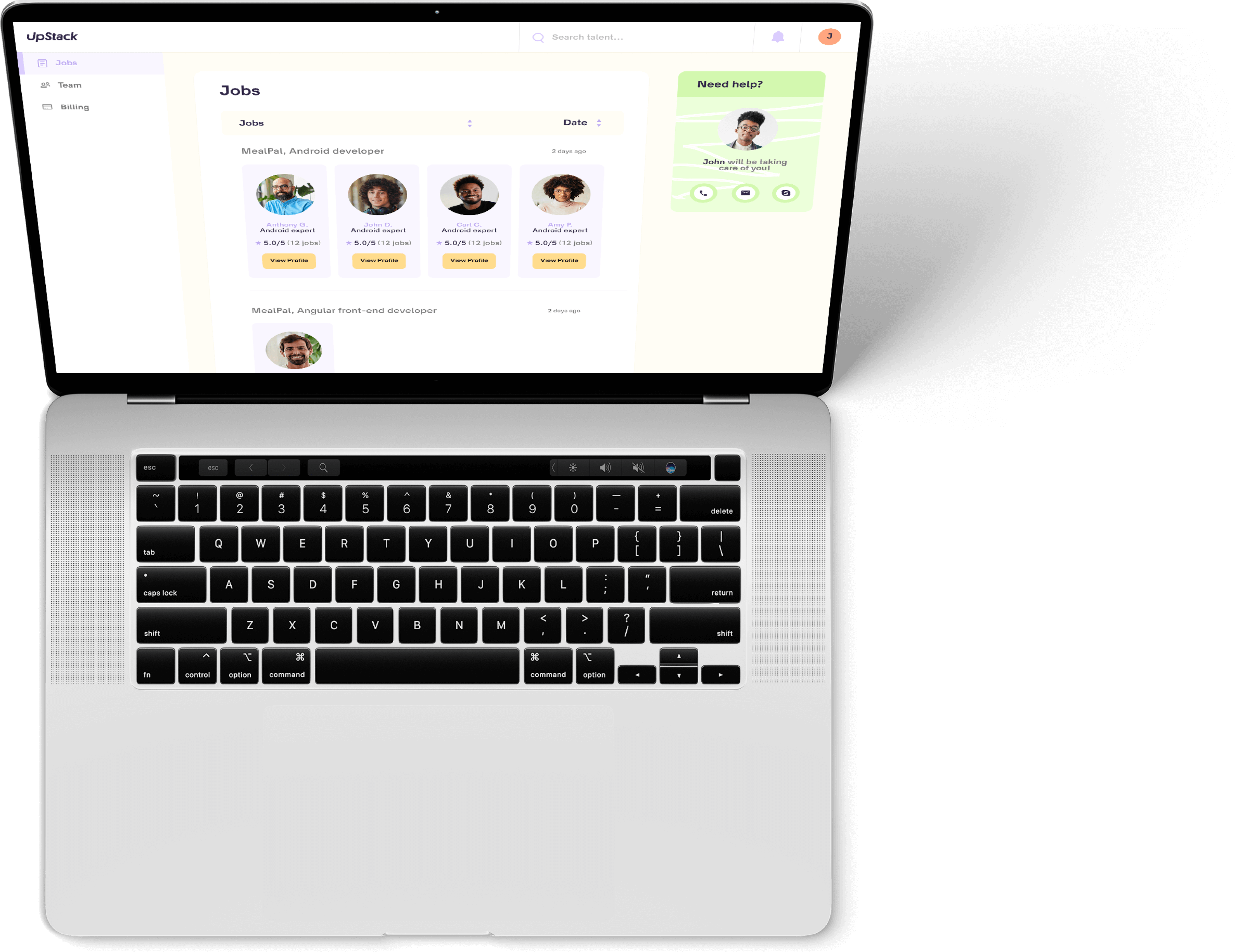


Schedule a Consultation and Hire a NestJS Developer
Stella B.
Available
Nest Js Developer
-
Experienced Nest Js engineer with seamless project implementation
-
Loves guacamole & hates spoilers

-
Marcus T.
Available
Nest.js Engineer
-
Stacked portfolio of beautiful, functional websites
-
Known for his epic charcuterie & cheese boards

-
David M.
Available
Mobile Developer
-
Mobile engineering guru with a knack for translating stakeholder needs
-
Would rather be diving Palau's Blue Corner

-
Top NestJS Developers with UpStack
Hire NestJS Developers with UpStack
What Is Nest.js?
Nest.js is a powerful JavaScript programming language that is used for developing server-side applications. It is based on the popular Node.js framework and is used by app developers for creating reliable and secure web applications. It is an open source language and is supported by a large community of developers. NestJS is a combination of the best features of different programming languages like TypeScript, Angular, React, and Node.js. It is a powerful and versatile language that is used for both client-side and server-side applications. It is a great choice for developing enterprise-grade applications with high performance and scalability.
Benefits of Hiring Remote NestJS Developers
There are many benefits to hiring remote NestJS programmer for your project. Here are some of the top benefits of hiring remote NestJS developers:
- Access to a larger pool of talent: Hiring remote NestJS developers gives you access to a larger pool of talent, as it is not limited to a particular geographic area. This allows you to hire the best developers for your project, regardless of where they are located.
- Cost savings: Hiring remote NestJS developers can help you save money on costs such as office space and other overhead costs. Remote developers are also usually cheaper than in-house developers, as they don’t have the same overhead costs.
- Increased flexibility: Hiring remote developers gives you more flexibility with your project, as they can work on the project from anywhere. This can help you get the project done faster and more efficiently.
- 24/7 support: Remote developers are available around the clock, so you can get your project done quickly and efficiently.
Reasons To Hire Remote NestJS Programmers
There are many reasons to hire remote NestJS programmer for your project. Here are some of the top reasons to hire remote NestJS developers:
- Expertise: Remote NestJS developers are highly knowledgeable and experienced in their field. They are well-versed in the language and can help you develop a secure and reliable web application.
- Accessibility: Remote developers are always available and can be contacted at any time. This makes it easier to get your project done quickly and efficiently.
- Flexibility: Remote developers are flexible and can work on the project from anywhere. This can help you get the project done faster and more efficiently.
How To Find The Right NestJS Developer For Your Project
Finding the right NestJS developer for your project can be a daunting task. Here are some tips for finding the right NestJS developer for your project:
- Research: Do your research and look for experienced and knowledgeable NestJS developers who have the skills to handle your project.
- Check reviews: Read reviews from previous clients and find out how satisfied they were with the developer’s work.
- Ask for references: Ask the developer for references and contact them to get an idea of the developer’s work.
- Check portfolios: Check the developer’s portfolio to see the kind of projects they have worked on.
Tips For Successful Remote NestJS Development
Remote NestJS development can be a daunting task, but it doesn’t have to be. Here are some tips for successful remote NestJS development:
- Set clear goals: Make sure you set clear goals and expectations for the developer before the project starts.
- Make sure the developer understands your project: Make sure the developer understands your project and the requirements before they start working on it.
- Communication is key: Make sure to keep an open line of communication with the developer to ensure the project is progressing smoothly.
- Test regularly: Make sure to test the project regularly to make sure it is functioning correctly.
Courses To Learn Remote NestJS Development
If you are looking to learn remote NestJS development, there are many courses available online that you can take. Here are some of the top courses to learn remote NestJS development:
- NestJS Crash Course: This is a great course for beginners who want to learn the basics of NestJS development.
- Advanced NestJS: This is an advanced course that covers more advanced topics such as authentication, authorization, and testing.
- NestJS Fundamentals: This course covers the fundamentals of NestJS development, such as the language structure and components.
- NestJS for Enterprise Applications: This course covers the best practices for developing enterprise-grade applications with NestJS.
They trust Our NestJS Developers
Why hire a Nest.js developer with UpStack
![Nest Js Developer and Programmer]()
Top Nest Js talent pre-vetted for a perfect fit.
Our 8-point assessment evaluation ensures that every senior Nest Js developer you interview exceeds expectations across technical, cultural, and language criteria.
![Nest Js Programmers Computer Icon]()
Hire reliable, passionate Nest.js developers.
From late-night sprints to jumping on a last-minute face-to-face, we ensure that your recruits are down to get the job done right.
![Nest Js Programmers High Five Icon]()
Risk-free 14-day trial.
Confidently onboard candidates with our no-questions-asked trial period. We'll walk you through the contract-to-hire process if and when you're ready to make it permanent with your new Nest Js engineer.
![Nest Js Computer Programmer Icon]()
Our Client Success Experts provide white-glove service.
Stay laser-focused on your business goals while our team of experts curates potential candidates and manages seamless programmer onboarding.
![Nest Js Developer Writing Notes Icon]()
Build your optimal team confidently, quickly.
UpStack handles everything including background and reference checks, legal issues, and more. Our platform streamlines billing, timesheets, and payment all in one easy-to-access place.
Schedule a call with a Client Success Expert to get starting hiring a Nest.js developer.
Start hiring Start hiring Start hiring
Hire from the Best.
Working with our Client Success Experts, we'll help you build the remote team of your dreams with top Nest Js talent from around the world.
Pre-vetted, reliable Nest Js developers are standing by.





Hiring Nest Js Developers | FAQs
How much does it cost to hire a Nest Js developer?
UpStack has a simple billing model where each Nest Js developer has a standard hourly rate averaging between $65-$75 per hour. Rates are based on skills, knowledge, and experience, and our developers are available mainly for full-time engagement (40 hours per week) and the occasional part-time opportunity (20 hours per week).
What is the process to find a Nest Js developer?
You'll connect with an UpStack Client Success Manager to determine your immediate needs. Our team uses a combination of AI and personal assessment to short-list candidates that match your job requirements. From there, you interview, select, and onboard the perfect developer, all within days of your initial call.
How does UpStack find its Nest Js developers?
UpStack's talent recruitment team connects with software developers around the globe every day. Each Nest Js programmer is vetted for technical, communication, and other soft skills necessary for a developer to successfully work with your team. Once vetted, the candidates are accepted into the UpStack developer community.
How is UpStack different from an agency or recruiter?
UpStack's community of available, pre-vetted engineering talent means minimizing roadblocks to scaling your team effectively, efficiently, and immediately. Our Client Success Experts work with you and your UpStack developer to ensure a smooth and seamless engagement.
Can I hire UpStack Nest Js developers directly?
Yes, you can hire UpStack Nest Js developers at any time, and with the same assurance of smoothly on boarding talent risk-free. First, we'd create a job opening on our portal. Then, we'd vet, interview, and match developers that meet your needs. If you're satisfied at the end of the 14-day trial period, at any time you can directly hire them.
Common NestJS Questions
How to Install NestJS
To install NestJS, you will need to have Node.js and npm (the Node.js package manager) installed on your system. Once you have those installed, you can follow these steps to install NestJS:
- Open a command prompt or terminal window and navigate to the directory where you want to create your NestJS project.
- Run the following command to create a new NestJS project:
Copy codenpm init nest-app my-nest-app
- This will create a new directory called my-nest-app and initialize it with the default NestJS project files and dependencies.
- Next, navigate to the new project directory and run the following command to install the project dependencies:
Copy codecd my-nest-app npm install
- Once the dependencies are installed, you can start the NestJS server by running the following command:
Copy codenpm run start
- This will start the NestJS server on your local machine and you can access it at http://localhost:3000.
- You can now start building your NestJS application using the provided tools and features.
How do I debug NestJS in VS Code
To debug NestJS in Visual Studio Code (VS Code), you can follow these steps:
- - Open the NestJS project in VS Code.
- - In the VS Code editor, go to the Debug tab and click on the gear icon to create a new launch configuration.
- - Select "Node.js" as the environment and give the configuration a name, such as "NestJS Debug".
- - In the "program" field, enter the path to the main NestJS entry file, which is typically src/main.ts.
- - In the "args" field, enter the command-line arguments that you want to pass to the NestJS application when it starts, such as -e development for the development environment.
- - Click on the "Create" button to save the launch configuration.
- - Go back to the Debug tab and select the new launch configuration from the dropdown menu.
- - Click on the "Start Debugging" button to start the NestJS application in debug mode.
- - In the VS Code editor, you can now set breakpoints in your code by clicking on the line numbers. When the application reaches a breakpoint, it will pause and allow you to inspect the current state and variables.
- - You can use the debug toolbar at the top of the VS Code editor to control the execution of the application, such as stepping over, into, or out of a function, or continuing execution until the next breakpoint.
- - You can also use the debug console to execute commands and evaluate expressions while the application is paused.
- - When you are done debugging, you can stop the application by clicking on the "Stop Debugging" button in the Debug tab.















